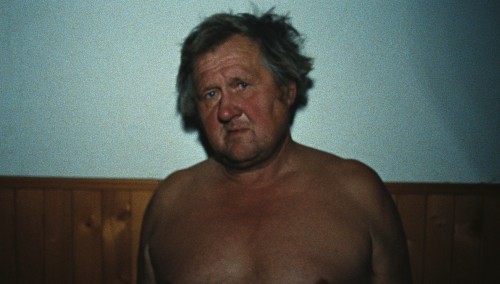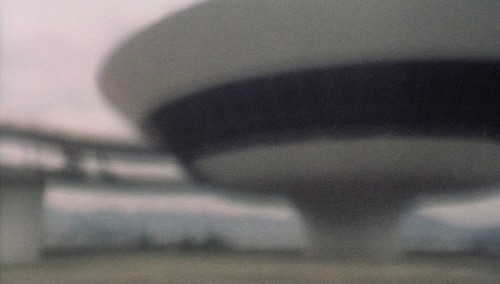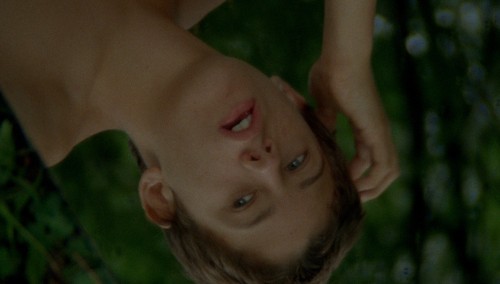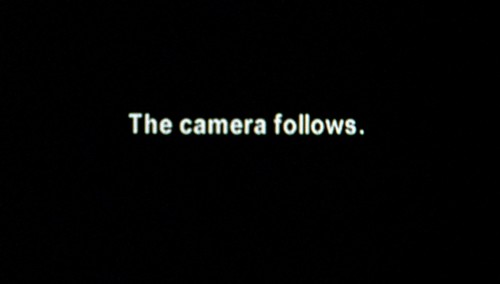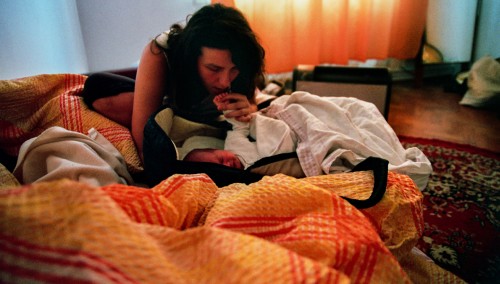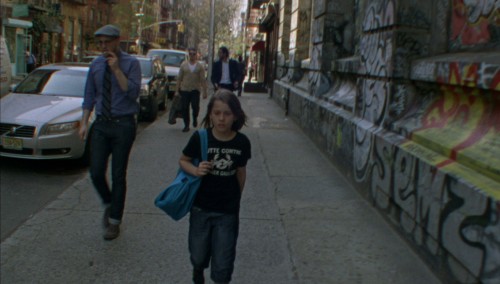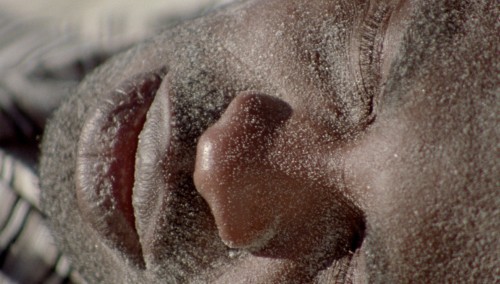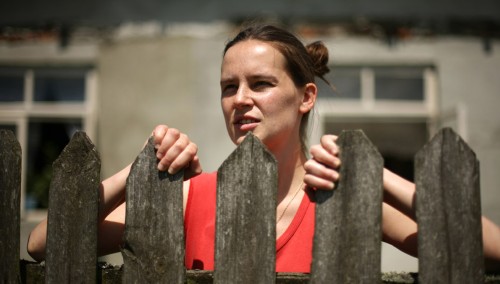Biography
Anka Sasnal, born in 1973 in Tarnów in Poland, studied Polish literature and gender studies. As a screenwriter, editor, and filmmaker, she lives in Kraków together with Wilhelm Sasnal, who was also born in Tarnów in 1972 and studied architecture and painting. Wilhelm Sasnal attracted international attention as a visual artist with a series of solo and group exhibitions in renowned international galleries and art institutions with paintings, comic books, drawings, photographs, and videos. From the first joint film project onwards, significant characteristics of their artistic collaboration are already visible: the intensive focus on language, texts, and literary models, which they transform into an image language that suits them. An explicit political stance can be noted in their films – thematically Anka and Wilhelm Sasnal circle around the current state of Polish society, rising xenophobia, the relationship of Polish society to the Catholic church, and especially the recent Polish past during the Second World War. A dystopian worldview, although not so much a pessimistic one – as they say themselves – may certainly be attributed to their work, along with an undisguised interest in the “dark” side of human beings.
Anka and Wilhelm Sasnal are no strangers to the festival audience in Linz, as they have already been represented in the festival program twice in the past. In 2012, they won the main prize with It Looks Pretty from a Distance, which premiered in Rotterdam, and then returned with Parasite in 2014.
Films at CROSSING EUROPE Film Festival 2017
Co-directed films: Słońce, to słońce mnie oślepiło (The Sun, the Sun Blinded Me, 2016), Huba (Parasite, 2014; CE ’14), Aleks ander (2013, doc), Z daleka widok jest piękny (It Looks Pretty from a Distance, 2011; CE ’12), Świniopas (Swineherd, 2008)
Films by Wilhelm Sasnal: Afternoon of a Faun (2015, short), Columbus (2014, short), Inhuman Hunger (2014, short), Kacper (2010, short), Europa (2007, short), Brazil (2005, short), Marfa (2005, short)
The Specters of Alienation
(Claudia Slanar, Film schoolar and curator, AT)
In the short film Columbus, made in 2014, an image keeps recurring, but what it depicts remains unclear for a long time: A kinetic sculpture? A double helix? Or maybe a broadcasting tower after all? The architecture is first shown in a reduced scale as a model, the actual building comes into the picture much later. Toward the end of the film, the fog coming in cuts through the broadcasting tower and the top part suddenly looks like a passing sailboat. The inserted text of the tale of the colonization of the American continent from the perspective of Christopher Columbus, plagued by bipolar episodes and ultimately without a place or a home, and what is shown in the picture finally coincide – and the past undergoes a temporal update. This puzzle picture – the symbolic charging of an object with the simultaneous obscuring of a situation, which can only be “resolved” in retrospect – is characteristic of many of Anka and Wilhelm Sasnal’s films. At the formal level this follows a narrow framing and a section-like perspective, which focus less on the inability to see clearly, but rather on being thrown back on one’s own, necessarily limited perspective. This means that the camera work, for which Wilhelm Sasnal is usually responsible, is shifted to the foreground along with the question of which subject is looking here with which intention. The camera becomes a co-actor – also literally in Swineherd – a subjectivized object and a representative for the filmmakers themselves.
Also in their most recent film The Sun, the Sun Blinded Me – an interpretation of Albert Camus’ famous novel “The Stranger” – the camera always stays close to the protagonist Rafał Mularz, looks over his shoulder, looks with him at the world, toward which he remains so distant. In two scenes the sections finally increase into a staccato of faces, gestures, and mouths articulating the usual slogans in defense of restrictive European migration and asylum policies. At a barbecue evening during a short holiday that Rafał and his lover take, racist jokes are made about a migrant from an African country. In the ultimate murder trial against Rafał, various witnesses take the stand, whose statements resemble one another in their conservative-racist tenor. In these memorable montages, which rely on an intensification of the statements through repetition, fragmentation, and quick cuts, it becomes clear how corrupt and morally depraved the “pillars of society” actually are, namely the military, the church, and the newly wealthy entrepreneurs. In the anti-hero of this film, the contemporary counterpart to Camus’ Meursault, there is a consolidation of the theme already addressed in early films, the postmodern subject’s alienation from the world, from society, and from oneself. Jean-Paul Sartre allegedly once said about Camus’ figures that the author had built a glass wall between them and us, which lets everything through except the meaning and the motivation of their actions. In analogy to the literary original, there is also much in the film that remains unclear and alien, not only for Rafał, but also for the viewers. At the narrative level, dream and reality are intermingled. Reality effects, like the documentary framing of a theater rehearsal where Rafał’s lover works, permeate the filmic narrative and exhibit the construction of what is seen. Milieus, relationships, moods are set up to be more opaque than transparent. The “Arab”, a Black migrant in the Sasnals’ interpretation, whom Rafał ultimately murders, is just as much an image of this opacity in his shadowy presence.
“We try to find a balance between the abstract images and the reality we want to depict. Images and atmosphere are more important to us than the plot,” said Anka and Wilhelm Sasnal in 2014 about their film language in an interview. Born and raised in the small Polish town of Tarnów, both come to film via circuitous paths, because Anka Sasnal first studied literature and cultural studies, and Wilhelm studied architecture and art. Becoming one of the most well-known painters of his generation, he soon began to make short videos and films, often in conjunction with exhibitions or during stays abroad.1 Although they had already worked together before, Anka Sasnal was first officially named as co-author and codirector in the feature-length films. Their biography generally plays a prominent role in their filmmaking: Their children can be seen in some films, and in two of the shorter, poetic works – Kacper and Afternoon of a Faun – they play the main roles. Much is filmed near the Sasnals’ place of residence at the edge of Kraków or even in their home itself. Swineherd, It Looks Pretty from a Distance or Aleksander portray rural and small town milieus, which are familiar to the filmmakers from their own experience. In these films they deal with autobiographical stories that are closely interwoven with the history of Poland at the same time. “History is not only a question of facts,” Wilhelm Sasnal said in 2011 about the historical motifs in his painting. “It applies directly to my life. That’s why I can’t separate it from the current moment.” In Swineherd as well as in It Looks Pretty from a Distance it is especially repressed history that irrupts into the filmic present, whether in the form of objects pulled out of the swamp by swineherds or protagonists who seem to experience the same events as five, ten or forty years ago. The annihilation of the majority of the Jewish population of Tarnów and the complicity of Poles in the crimes committed after the Germans invaded Poland have only been processed in recent decades – the process is still ongoing and it occupies Anka and Wilhelm Sasnal. Unprocessed experiences and the traumas of the victims and the perpetrators are perpetuated across generations and make use of the vicious circle of a society that is repressive and submissive to authority. The alienation of some of toward the world and toward themselves can ultimately be understood as an expression of these mechanisms of repression.
The concomitant speechlessness of the people in It Looks Pretty from a Distance and in Parasite is certainly striking. In addition, there is neither a classical score nor music that interprets or situates the events. Where people have become alien to one another, things are charged with affects and stories. The soundspace of the films is devoted to the motor noises, machines, tools, and manipulations of manual labor. When Paweł, the protagonist of It Looks Pretty from a Distance, picks up his girlfriend from her parents’ house, there is no greeting, no hello. They drive for some minutes along a rural road into a little forest as it becomes dark outside. The roar of the motor, changing gears, the tires rubbing on asphalt and gravel dominate the sequence, which can be situated in the American road movie of New Hollywood. In Monte Hellman’s Two-Lane Blacktop (1971), for instance, an equally silent driver, his friend, and a young woman drive through the US and take part in street racing. In both cases, cars play a particular role, almost like additional protagonists, which are equally vulnerable to violence – as in the beginning of It Looks Pretty from a Distance, in a mirroring of the short film Marfa, made long before.
In Parasite the mechanical world itself is capable of opening something up: one of the two main figures, a mother who often seems apathetic, rocks her screaming baby in a buggy at a playground, while the squeaking of play equipment is heard from off-screen. Ever more insistent, this becomes the repetitive score accompanying the recurring 360 degree pan of the camera. Mother and child are only part of an environment of residential buildings and children on swings, slides, and climbing towers. This sequence follows no feature film conventions, but comes from experimental film and enables a perspective between claustrophobia and euphoria. This is only one example of the way images and sequences step out of the chronotope of the narrative, which often functions particularly through the use of music. Music also plays a very special role in the shorter works as well, mostly made between 2005 and 2007, which are distinguished by an open narrative structure and atmospheric images and sequences usually conjoined associatively: Marfa is produced like a music video for a local rock band, where the preceding course of events aims at their rehearsal and performance in the Texan desert. Music opens up a space of associations, a further narrative level. In Brazil it is the different styles of music – from hip hop to pop – that atmospherically charge or contrast what is shown. These qualities are retained in the short films and in some of the feature-length films: in a scene in Swineherd, for instance, the farmer’s daughter, who has to watch the farm alone, browses through a book with pictures of paintings. She suddenly encounters the photograph of a suspension bridge, which triggersthe Sasnals’ protagonists something: memory, dream, premonition? The song “(Sittin’ on) The Dock of the Bay” by Otis Redding (interpreted by T. Rex), which immediately starts playing, reinforces this moment that opens up a different possibility. In a different country, at a different time in the same film – but later – shots of young men in a technical school can be seen, accompanied by the bluesrock of the band Cheveu. Through the confusion of time and forms of reality, these documentary images mark the effects and after-effects of geo-political and socioeconomic changes, which nevertheless hardly seem to influence the individuals.
Is this world view, Anka and Wilhelm Sasnal’s filmic universe a deeply pessimistic one then? Is history the return of the eternally same here? Perhaps it helps to look again at the very apt Camus adaptation The Sun, the Sun Blinded Me. Anka and Wilhelm Sasnal shift the history and problems of the relationship between colonial power and the colonized from the coast of Algeria to the coast of Europe, which currently has to deal with the impacts of centuries-old colonial policies. Although Rafał can look away, he cannot “think away”. The “Other” penetrates his apathy, resulting in panic and desperation. The equation, which is already alluded to in the novel, of Meursault and “the Arab” as “the Other” (not belonging to French society) is now honored. Although he has been killed by Rafał, the fate of the two is so intertwined that the migrant reappears as a very real ghost or “shadow”. His run at the end mirrors Rafał’s obsession, but it is breathless, driven, ultimately a coup. The “Arab” becomes a figure from a different genre, that of the young rebel running against society with the knowledge of being faster in any case. Yet the famous Polish punk band Siekiera admonishes that the old ghosts should still not be forgotten: “Do they claim the Madonna? Are they still men of honor?”



